Impact report 2024-25
We believe we will only deliver through the development of class-leading capabilities and by working in partnership across NHS providers, university partners and industry.
The UK Government’s anticipated 10-year plan includes three key shifts: from analogue to digital, from sickness to prevention, and from hospital to community care. Aligning with this vision we have, over the last year, made great strides in digital innovation, prevention strategies and community-based care. We have united NHS leaders to drive AI adoption in our health systems, prevented heart attacks and strokes in our population, and driven a radical rethink of how the NHS buys its energy supply.
Set to become a world-leading health innovation cluster, Hale House places us at the heart of London’s rich ecosystem of hospitals, research institutions, and life sciences pioneers. We will actively shape the ecosystem by attracting and collaborating with top health tech innovators, providing the support and strategic partnerships to help them grow and scale in London and beyond.
These achievements underscore our commitment to create health and wealth through effort, strategic collaboration and by being willing to think differently.
I’d like to thank all our teams and our partners for their hard work and dedication over the last year and look forward to an exciting year ahead.
Kind regards,
Dr Chris Laing, CEO

